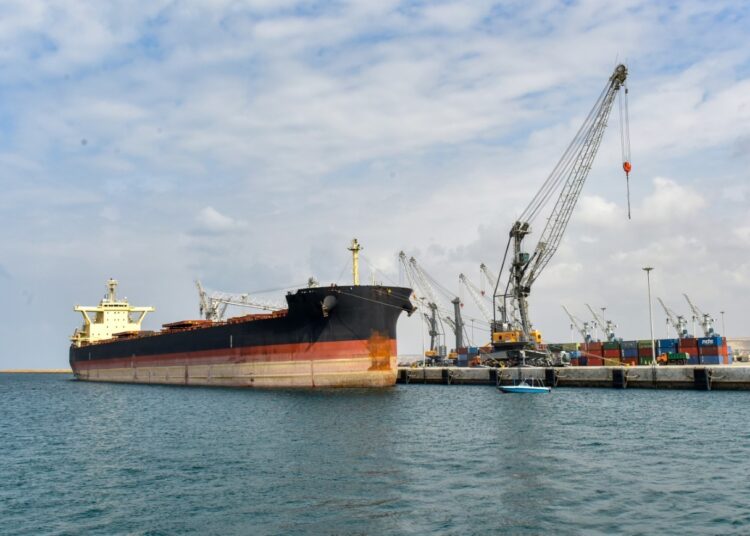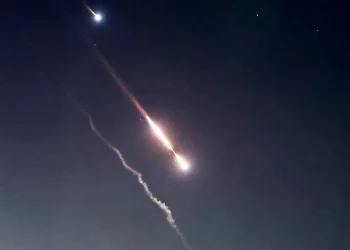After years of festering, Iran-India relationship has slid into the abyss of mistrust and bad-faith; It requires fresh ideas and vitality, and soon.
By Saurabh Kumar Shahi
The cranes appear out of nowhere. The road leading to the port has few cars, or any vehicles for that matter. At a few stretches, one can see some construction activities going on. But one cannot find any sense of urgency in them. A little further on your right, for several hundreds of meters, there are just containers and more of them. Then, as the car takes a swing toward the right, you see the mammoth cranes in blue. All four of them. Standing mothballed at the Shahid Bahesti Terminal at Chabahar Port, these cranes, bought and transported here by India, are a testament to the current state of the Iran-India relationship.
As a journalist covering West Asia, I first came to hear about Chabahar almost a decade and a half ago. As the Western Powers drew to a stalemate in Afghanistan, they actively looked for partners closer to the accursed country. The Right-Wing ruling dispensation in India saw an opportunity and betted heavily on the regime in Kabul; both in terms of money and material. As Pakistan baulked at the prospect of having an Indian presence on its western border as well, it started playing spoilsport. Americans, always prone to kneejerk reactions, had doomed Afghanistan with that one move.
New Delhi was more euphoric. A way to Central Asia, and further to Eurasia appeared to have opened up. India was determined not to miss the Third Industrial Revolution and the aforementioned market appeared to be the key to that aspiration. There was just a small matter of Pakistan though. Entered Chabahar.
The power corridor in New Delhi buzzed with enthusiasm around Chabahar to the point where Indians appeared to be more gung-ho about it than the Iranians themselves. Indian journalism, which primarily works around the handouts provided by different ministries, lapped up the issue with some vigor and more. Articles, opinion pieces and even cartoons tried to explain to the domestic audience how India has bypassed Pakistani Geography by hitching its wagon to Chabahar Port. Even a cursory look on Google will tell you that Indians wrote and consumed several times more news about Chabahar Port than Iranians themselves. It reached its crescendo in and around 2018-2019 when it started to be projected as a counterfoil not only to Pakistan but also to the Chinese-built Gwadar Port under the Belt & Road Initiative (BRI).
All the while, a few of the journalists, including yours truly, were trying unsuccessfully to tamper with the expectations. For starters, a port in itself was nothing. One needs to have a transportation infrastructure and market around it. India committed to investing in the Chabahar-Zahedan Railway Link. The idea was, as things stabilize in Afghanistan, and India gets preferential allocation of mineral mines, this railway line linked to the port will be beneficial to the Indian economic interest. Unlike helicopter journalists who just drop into capital cities to write about a place occasionally, those of us following the conflict closely realized that the Taliban takeover of Afghanistan was a matter of when and not if. This put Indian investments both at the Iron Ore blocks in Hajigak and Copper Mines at Shaida in extreme jeopardy.
By late 2019, the prospect of the American withdrawal in defeat and the Taliban takeover hit the mandarins in New Delhi on their faces. It came on the heels of the Trump Administration unilaterally pulling out of the Joint Comprehensive Plan of action (JCPOA) and imposing “maximum pressure” sanctions on Iran. Suddenly, for India, investing in the Chabahar ecosystem became a political decision and not an economic one.
Cut to July 2023 and things have not moved even a bit as far as Indian interest in Chabahar is concerned. Funnily, India has started to walk back on most of the bluster. An Indian official, on the condition of anonymity, maintained that India had never promised to revitalize the port and that it had only promised that it will use the port as and when it is worthy of using. This explanation is a bit disingenuous and flies on the face of the hundreds of thousands of bluster articles Indian media has put out in the decade and a half gone by.
With Afghanistan largely gone, India’s, and by that extension Iran’s, hope is now hung on the operationalizing of the International North-South Transport Corridor (INSTC) between Russia and India. However, it is easily said than done. This program has been in limbo even more than Chabahar is. And while the geopolitics post-Russia’s invasion of Ukraine has given it a fresh lease of life, it is also looking at the prospect of a cold start.
It is evident that while India has enough strategic capital to thumb the nose of the Americans on the issue of sanctions against Russia, it is just not enough to do so on the issue of sanctions against Iran, even if both are unilateral in nature.
The truth is, the import of Iranian crude by Indian Government owned companies has come down to almost zero. Even though countless Indian officials as well as technocrats representing the interests of the oil sector in India have admitted that Indian refining infrastructure is more in line with the Iranian crude than any other crude in the world including Russian. Very clearly, India considers Russia vital to its survival; Iran, not so much.
This dithering has turned the mood in Tehran—and in Chabahar so to speak—sour. There are regular statements in support of each other and occasional high-level visits as well, but the vitality in the relationship is gone. So yes, Indian national security adviser Ajit Doval might do a photo-op in Tehran every now and then and support Iranian candidature to BRICS, the Iranians don’t appear amused.
At Chabahar Free Zone, Mohammad Miri, a senior advisor, looked like the personification of frustration. He presented a very well-argued and persuasive case for why India should deliver on its promise vis-à-vis Chabahar. Per Miri, Indian exporters can shorten the distance, and consequently the transportation time and cost, between the ports on India’s western coasts, especially in the states of Gujarat and Maharashtra, with those in Europe and eastern Russia. The Chabahar route shortens the existing routes via both Suez Canal towards the West and Malacca Strait in the East towards Vladivostok.
However, he also expresses frustration with the lack of courage shown by Indian firms in the face of unilateral sanctions. “The Indian corporate delegations come here, we show them around, they promise to get back but never do,” he laments. Privately, Iranians say that the same Indian firms have been actively participating in bypassing sanctions against Russia. Why not Iran then?
Indians insist that they never talked about investment and that it is for the Iranians to develop the port. They also insist that the four cranes that stand mothballed at Shahid Bahesti Terminal are the lion’s share of the investment that they promised. The second tranche of the investment has to do with Iranians buying Western equipment and India paying for them, which could not be done because of the sanctions. This begs the question that if the original promise was just for “using” the port and not investing in it, which other port that India “uses” has got the same column centimeter of space in the Indian newspapers as Chabahar does?
While this argument might cut some value in front of the domestic audience, it has no takers in the power corridors of Tehran. During his interaction with Indian journalists, Ali Bagheri Kani, the Deputy Minister for Political Affairs at the Ministry of Foreign Affairs of Iran, didn’t mince many words. He openly brought up the question of India’s passivity vis-à-vis Iran and lamented India’s toeing of the American line on sanctions against Iran.
When an Indian journalist raised the question about Iranian actions vis-à-vis Farzad-B Gas Field that a consortium of Indian oil giants had discovered and which was later given to an Iranian company for exploration over some conflict, and suggested it as a reason for the possible lack of faith in Iran, Bagheri curtly dismissed the series of events. He said that the initial proposal by the Indian consortium was not worthy of consideration and when they came up with an improved bid, it was accepted. Privately, officials from the Ministry told this correspondent that the Indian consortium was trying to blackmail Iran in the light of the fresh sanctions and was offering the price for gas which was half of what India was paying Qatar. “When we played hardball, an improved offer was presented which we accepted,” the official added in good measure.
The question arises as to why does Iran then want India so desperately in Chabahar if it has a litany of grievances against it? Well, to start with, Iran does not want to put all the eggs in one basket. Or to be more precise, in the Chinese and Russian baskets. Overdependence on any country is dangerous and Iran got a taste of it only recently when both China and Russia appeared to toe the Khaliji lines on the issue of the sovereignty of a bunch of islands in the Persian Gulf in the joint statements they released with the GCC countries. While China quickly walked back on it and mollified Iran, Russia refused to budge. Clearly, Tehran doesn’t want a situation in the future where it has less strategic space to maneuver on the issue of sovereignty. And if you remove China and Russia from the picture the only country with financial and military heft that can be used as a counterweight is India. It is not for nothing that at Chabahar, more than half a dozen officials admitted as much both publicly and privately. Even Ali Bagheri hoped that India will entertain the Iranian request for a 25 years comprehensive strategic deal similar to what the latter struck with China last year.
Then there’s the issue of trust deficit as well. While talking to the Indian media persons, Bagheri kept insisting that Indian media must form its own opinion on events inside Iran and should not be swayed by the narrative set by the Western news agencies to represent the interests of the respective capitals they are based in.
In contrast, Indian officials lamented about a trip to India they organized for Iranian journalists several months ago which ended on a sour note. “We familiarized them with scores of things and took them to several cities but what most of them ended up writing about was a faux pass made by one analyst from a private Think Tank who erroneously wrote the Persian Gulf as ‘Arab Gulf’ in his PowerPoint presentation.” Having said that, one wonders what would have happened if an Iranian Think Tank decided to write Jammu & Kashmir as “Indian Occupied Kashmir” on a PowerPoint presentation meant for the visiting delegation of Indian journalists. We can probably guess but will never know for sure.
Very evidently, everything is not hunky-dory between Iran and India. While both parties put a brave face in public and talk about civilizational connection, the relationship can do with a bit more vitality. The sanctions against Russia have provided that opportunity. It is for both the capitals to grab it.
The views expressed in this article are those of the author and do not necessarily reflect the positions of Iran Nuances.






